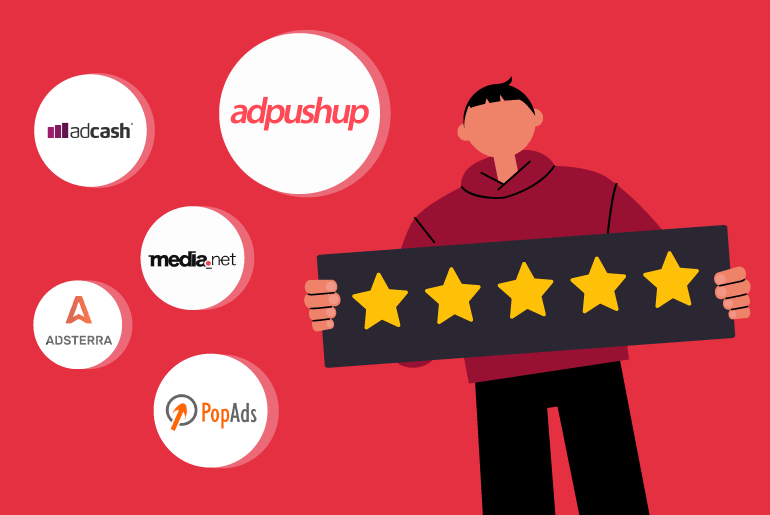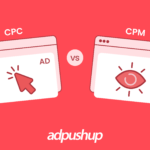A comprehensive list of the 30 Best Ad Networks. Learn about ad networks, how they work, and why publishers should choose them.
Whenever we talk about monetizing websites, the first name that pops up in mind is Google AdSense. While there’s nothing wrong with that—it is, after all, the world’s best ad network— it is unwise to assume that AdSense can’t be outdone by any other ad network.
The ad tech industry is ever-evolving. Therefore, it wouldn’t be a stretch to say that Google has competitors who can give them a good run for their money.
It may take some hit-and-trials to figure out which ad network, or a combination of ad networks, generates the highest revenue. However, after figuring it out, publishers can efficiently work on monetizing their websites.
What is Ad Network?
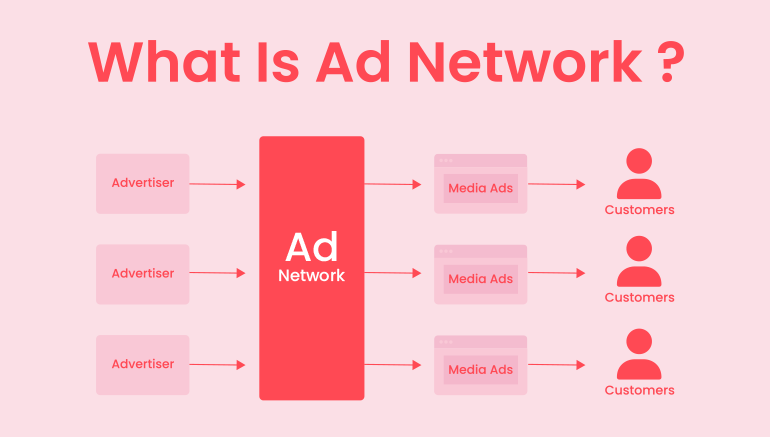
Ad networks acquire available inventories from a publisher and sell them to advertisers as packaged impressions.
In a simple inventory selling process, think of an ad network as a mediator responsible for introducing the right impression to the right buyer. It partners up with publishers (supply-side) and advertisers (demand-side) to help them reach their ad campaign goals.
Now, as the inventory exchange cycle gets complicated, the role of ad networks starts varying. For publishers, ad networks sometimes directly sell inventory and, at other times, buy inventory from SSPs or ad exchanges and sell it for a greater profit.
Most publishers are known to specialize in one particular type of ad format. Hence, publishers looking to monetize via one particular format should consider ad networks.
For instance, there are CPM ad networks like Criteo, known to offer the best CPM rate, and then there are video ad networks like Unruly, serving publishers with the best video content.
Why are Ad Networks Important?
Ad networks function as a commercial intermediary between publishers and advertisers. Within the advertising ecosystem, they act as essential monetisation elements. Without ad networks, publishers would have to negotiate deals with each individual advertiser.
Additionally, ad networks are known to efficiently work to sell remnant ad inventory. Basically, ad networks take remnant inventory from multiple publishers, segregate them on the basis of demographics, and sell the segmented impressions to advertisers specifically looking for similar impressions.
Doing this makes sure that the publishers’ inventory makes it to the right advertiser in time. It is clear by now that ad networks are essential for publishers.
What are Different Types of Ad Networks?
Choosing the right type of ad network depends on your specific needs and goals. Consider your target audience, budget, and desired results when making your decision.
There are various types of ad networks used in to generate results. While they act in congruence to each other, they can also work independently of themselves. Here are the common ad networks that fit the criteria.
1. Horizontal Ad Network
Horizontal ad networks provide advertisers with access to a diverse array of websites and apps spanning various industries, offering broad reach to a large audience. However, they may not be as effective for targeting specific audience segments.
Examples include:
- Google AdSense
- Media.net
- PropellerAds
2. Premium Ad Networks
They prioritize high-quality websites and apps with sizable, engaged audiences, granting advertisers access to premium inventory albeit at a higher cost. While they excel in reaching specific target audiences, they may come with a higher price tag compared to other options.
Examples include:
- The Rubicon Project
- Index Exchange
3. Premium Ad Networks
Vertical ad networks focus on specific industries or niches, providing advertisers with access to a targeted audience interested in particular topics. However, they might not have the broad reach of horizontal ad networks.
Examples include:
- Sovrn (finance)
- Outbrain (content discovery)
- Taboola (content discovery)
4. Performance-based Ad Networks
Performance-based ad networks compensate publishers based on the effectiveness of the ads, typically measuring clicks, conversions, or leads. While advantageous for advertisers seeking specific results, they may not provide stable revenue streams for publishers.
Examples include:
- ClickBank (affiliate marketing)
- MaxBounty (affiliate marketing)
- PeerFly (affiliate marketing)
How to Choose the Best Ad Network?
Finding the best ad networks is easy. There’s just one problem—there are just too many choices. And the jargon flying around in the ad tech industry certainly doesn’t help things. What is programmatic buying? Should you opt for CPC or CPM? Should you go with standard IAB units or the newer, more innovative types?
Firstly, understanding your audience and niche is paramount. Researching ad networks catering to specific industries or demographics aligning with your audience can enhance relevance and effectiveness. Additionally, evaluating ad formats offered by different networks enables you to prioritize those aligning with your preferences and content strategy.
Secondly, comprehending various revenue models employed by ad networks is crucial. Whether opting for revenue share, cost-per-mille (CPM), cost-per-click (CPC), or cost-per-action (CPA) models, selecting the most suitable one is essential for maximizing earnings.
Furthermore, assessing traffic requirements imposed by ad networks is vital, as it determines eligibility based on your platform’s visitor count. Striking a balance between accessibility and revenue potential is pivotal, especially for small publishers or high-traffic creators. Lastly, prioritizing user experience is paramount. Opting for ad networks emphasizing relevant, non-intrusive ads enhances user satisfaction and revenue generation, contributing to long-term success as a content creator.
Some of these questions may seem daunting if you haven’t particularly taken the time to dive in and understand how the online ad tech ecosystem works, so it may seem like choosing a network for your website is going to be a tough task, but it doesn’t need to be so.
In the end, it boils down to a few things you should consider to find out best ad network:
- Size of advertiser network.
- Quality of ads in the network.
- The variety is available in ad formats.
- Compensation & payment terms.
- The underlying technology.
Want more information on how to choose best ad network? We’ve compiled it all in this blog post:
5 Things You Need to Consider When Choosing an Ad Network.
Which is the Best Ad networks?
We have compiled a list of the best ad networks to help publishers to choose the one that suits them:
1. Amazon Publisher Services
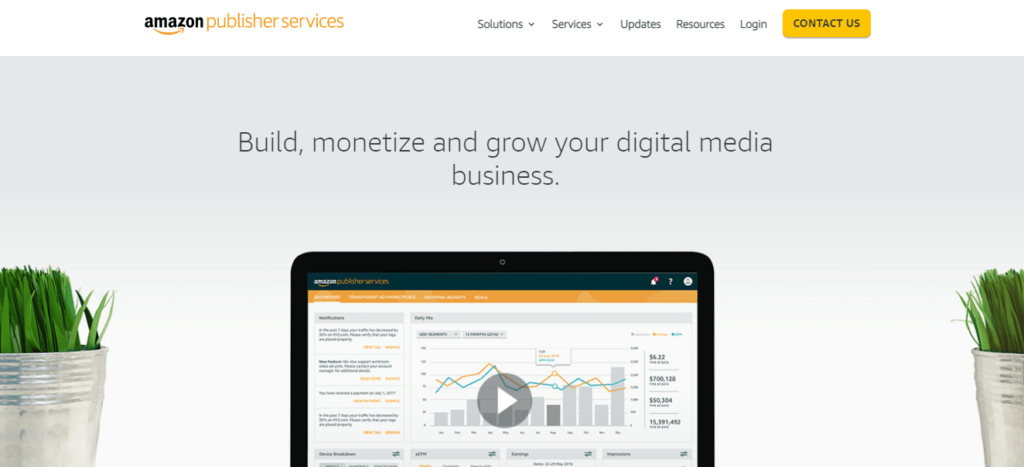
Whether you are a mid-sized publisher, small publisher, or a large publisher, Amazon Publisher Services has solutions for everyone. It is one of the best ad networks. Publishers are further provided with access to cloud-based solutions of header bidding, transparent marketplace, shopping insights, and unified ad marketplace.
Publishers can connect with buyers from all over the web, which can significantly increase their revenue. Additionally, publishers gain wider insights regarding their users via shopping data, thereby helping them to enhance user experience.
- Model: Depends on the demand partner’s model
- Minimum Traffic: 5000 unique visits a day
2. Popads
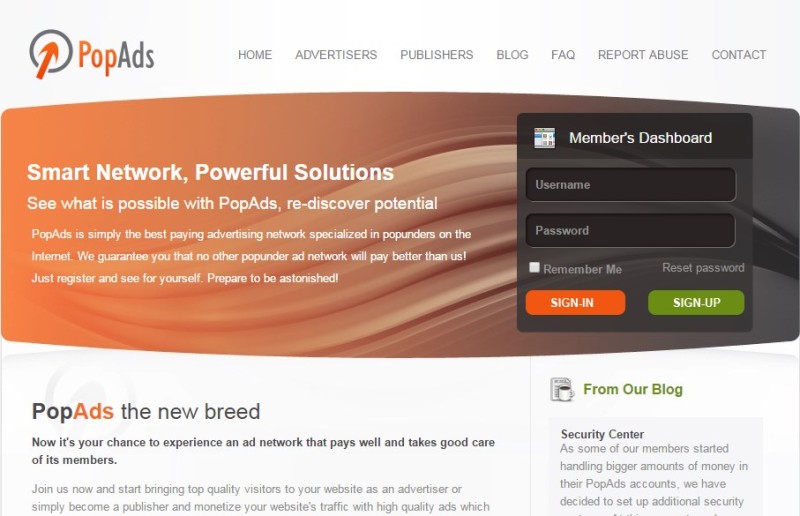
PopAds is a pop-under ad network that is known to be relatively faster and more secure than others like it. It gives publishers the medium to monetize their website traffic with the help of high-quality pop-under ads.
An advantage for publishers is that it allows on-request payments and access to advertisers from more than 40 countries. As a result, this provides publishers with a wide scope when it comes to the choice of keywords and targeting to effectively monetize the traffic in their niche. Hence, it is known as one of the best ad networks.
- Model: CPV, CPM
- Minimum traffic: None
Read more: PopAds Review (Pros, Cons, Payment)
3. Adcash
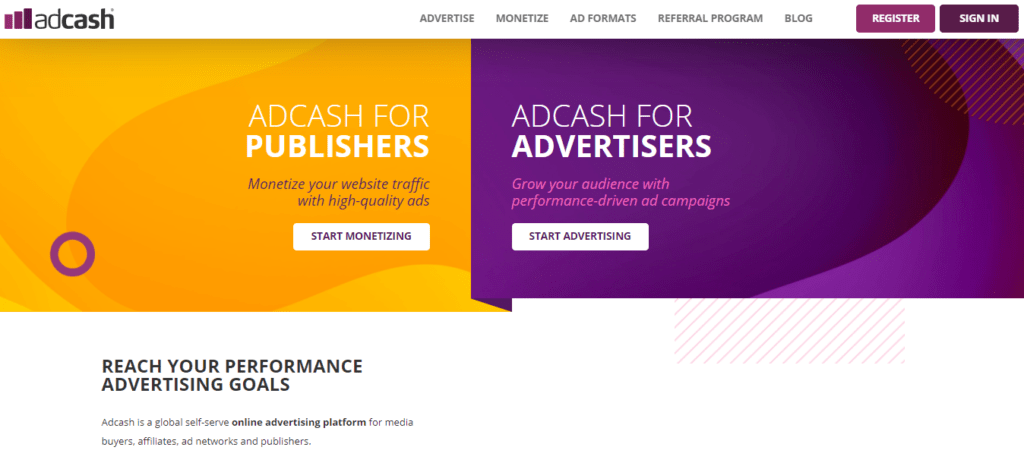
Adcash DSP+ is an online advertising platform for both advertisers and publishers with 10 000+ active campaigns across the world.
It offers all the best-performing ad formats for both web and mobile monetization, including pop-under, native ads, push notifications, banners, and interstitials. They have a number of tools and features that help publishers monetize their traffic more effectively. Furthermore, their technology bypasses adblockers, making it one of the best ad networks.
Publishers can expect high eCPMs, flexible payment terms, real-time stats, and support from them. Their experienced and multilingual account managers help publishers take their monetization strategy to the next level.
- Model: CPM, CPC, CPA Target
- Minimum traffic: N/A
Read more: Adcash Review (Pros, Cons, Payment)
4. Adsterra
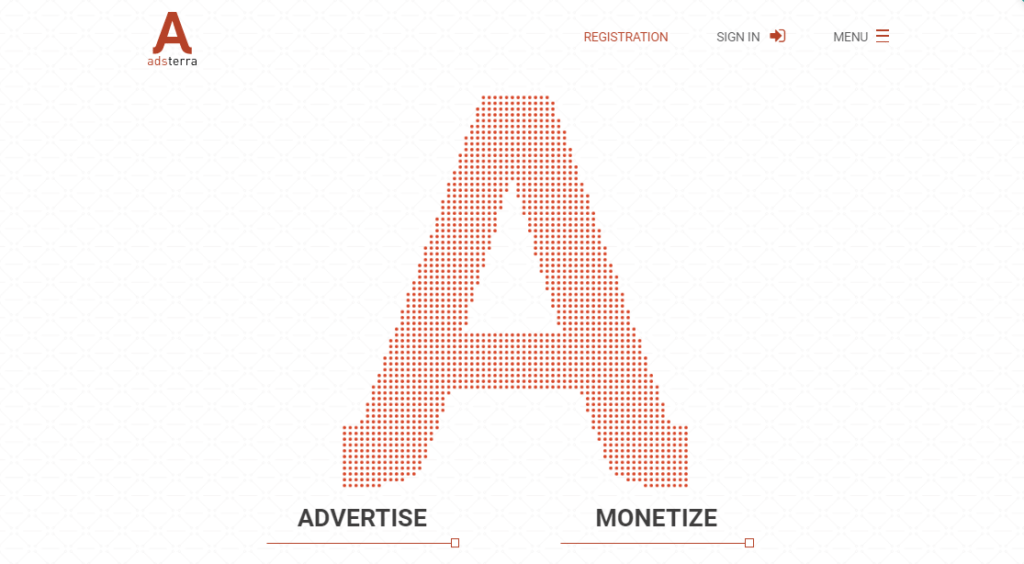
Adsterra is a reliable ad network with Partner Care, serving over 30 billion ad impressions per month worldwide. It is famous for its experienced and qualified team, unique direct traffic from all over the world, three levels of anti-fraud protection, and a wide range of advertising formats and payment methods.
Recently, Adsterra recorded more than 100K campaigns across 248 geographies serving over 30 billion impressions per month.
Publishers can monetize any traffic with Adsterra: desktop/mobile website traffic or social/mobile app traffic with Adsterra. One significant positive aspect of this ad network is that publishers can choose from its range of multiple ad formats: Popunder, Social Bar (total blast!), In-Page Push, Native, Banners, VAST (Pre-Roll Video).
- Models: CPC, CPM, CPI, CPA, CPL
- Minimum traffic: None
Read more: Adsterra Complete Review
5. SmartyAds
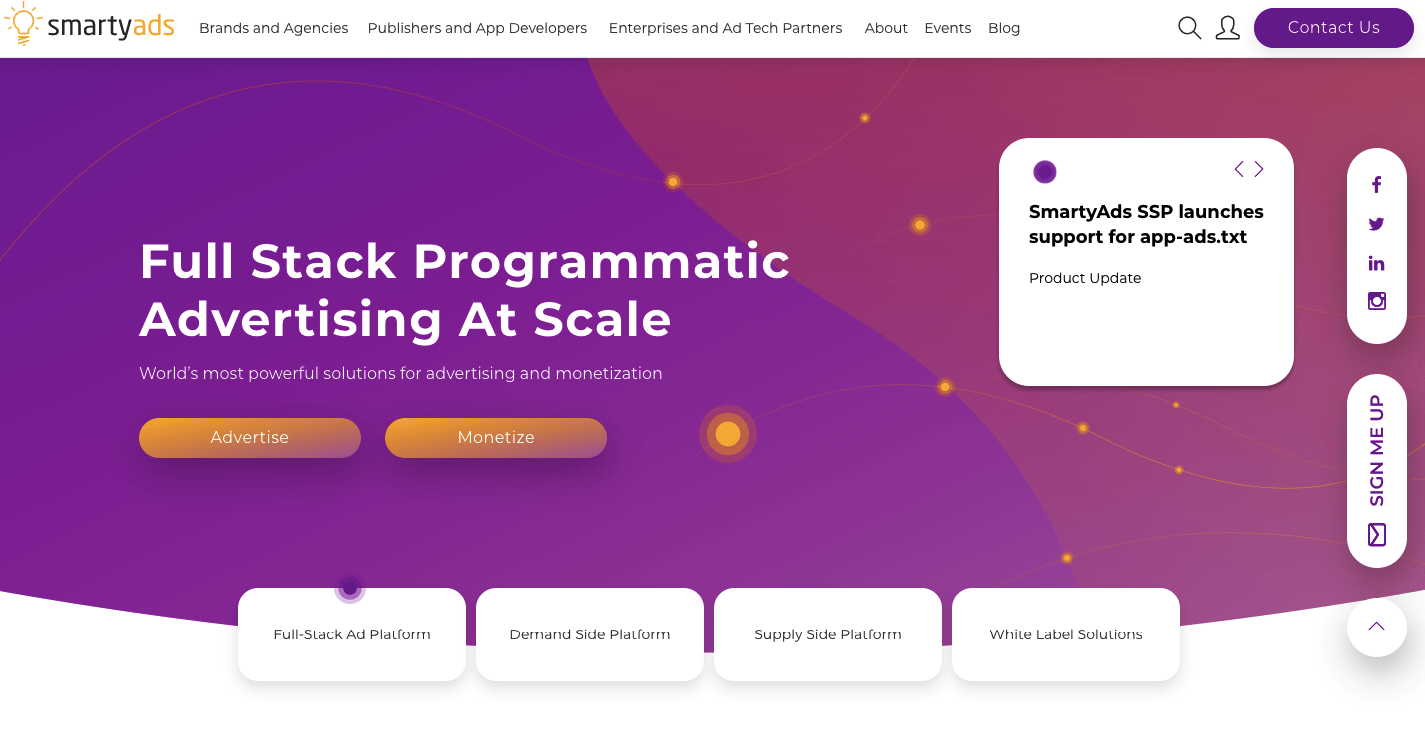
SmartyAds SSP is a media-selling network created for publishers who seek intelligent revenue optimization.
Their cross-environment header-bidding wrappers (desktop, mobile, or in-app) and high-volume private marketplace deals intensify competition for inventory and help grow publishers’ yield.
They serve over 2 billion daily impressions driving the highest eCPMs, CTRs, and fill rates across all geographies, which climb up to 100%.
SmartyAds also offers a range of desktop and mobile ad formats, viz., rewarded videos, interstitials, native ads, and banners.
Their lightweight and latency-free IOS and Android SDK enable mediation which sends requests to a large number of ad networks and DSPs.
Their partnerships with top-demand partners in global monetizing geographies benefit publishers with highly-targeted personalized advertising with ease and make them the best digital advertising platform.
- Model: CPM
- Minimum traffic: None
Read more: SmartyAds Complete Review
6. TrafficForce
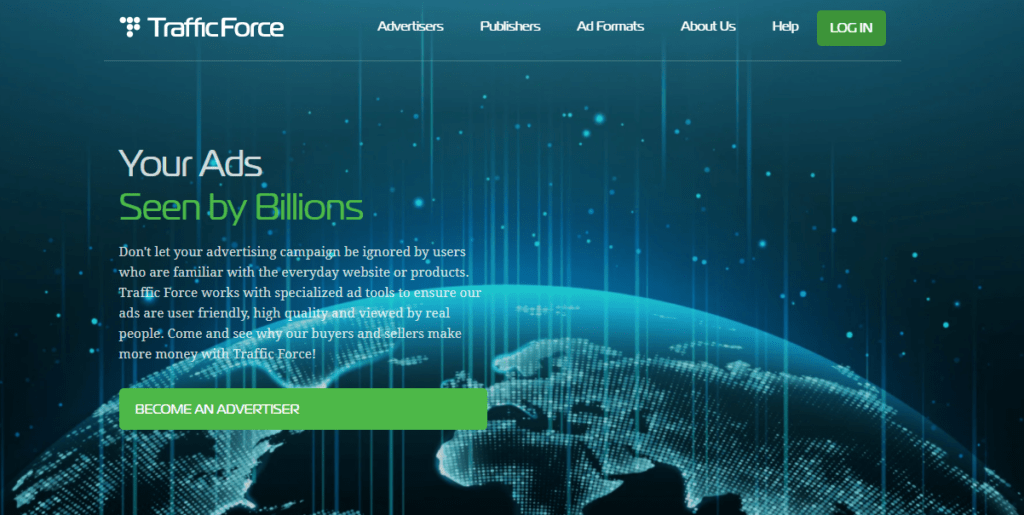
TrafficForce helps publishers and advertisers maximize their ad revenue by offering various forms of online advertising. The ad network sells targeted website and mobile traffic on an impression basis.
Being a supply-side platform, the network helps publishers gain access to over 100 demand-side partners. They follow the header bidding or open RTB technology to deal with traffic.
Known to be among the best ad networks, Traffic forces offers ad formats like display banners, pop-under, IM floater, and in-stream video ads for publishers to leverage.
- Model: CPM
- Minimum traffic: None
7. PropellerAds
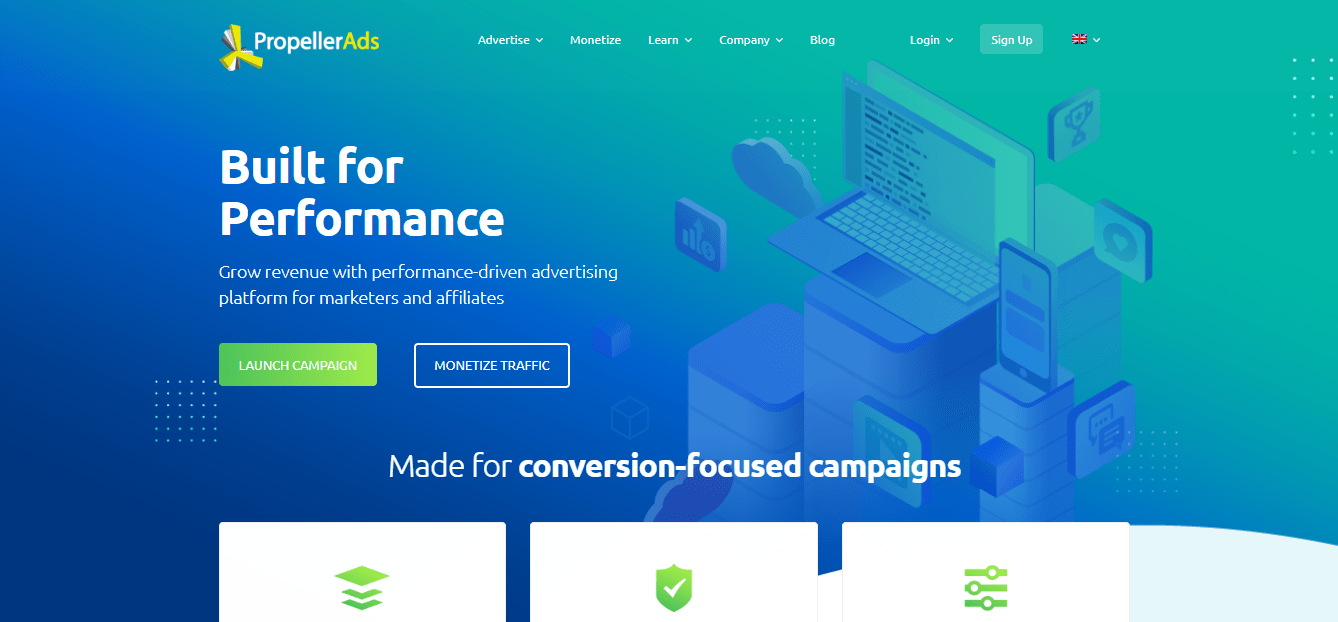
PropellerAds supports banner ads in all standard sizes, such as 728×90, 300×250, 160×600, and 120×600, apart from on-click and in-banner video ad formats. Therefore, if the ads are positioned strategically, publishers can expect CPMs as much as $1-2 for US and UK inventory.
They have 70,000 active campaigns worldwide and perform manual checks to remove all unsafe and suspicious advertisers, thereby ensuring high ad quality. Known to be among the best ad networks, propeller ads publishers also get the benefit of a 100% monetized inventory, in-time payouts, a personal account manager, and detailed real-time reporting.
- Model: CPM, CPC, CPA
- Minimum traffic: None
Read more: Propeller Ads Review
8. Media.net
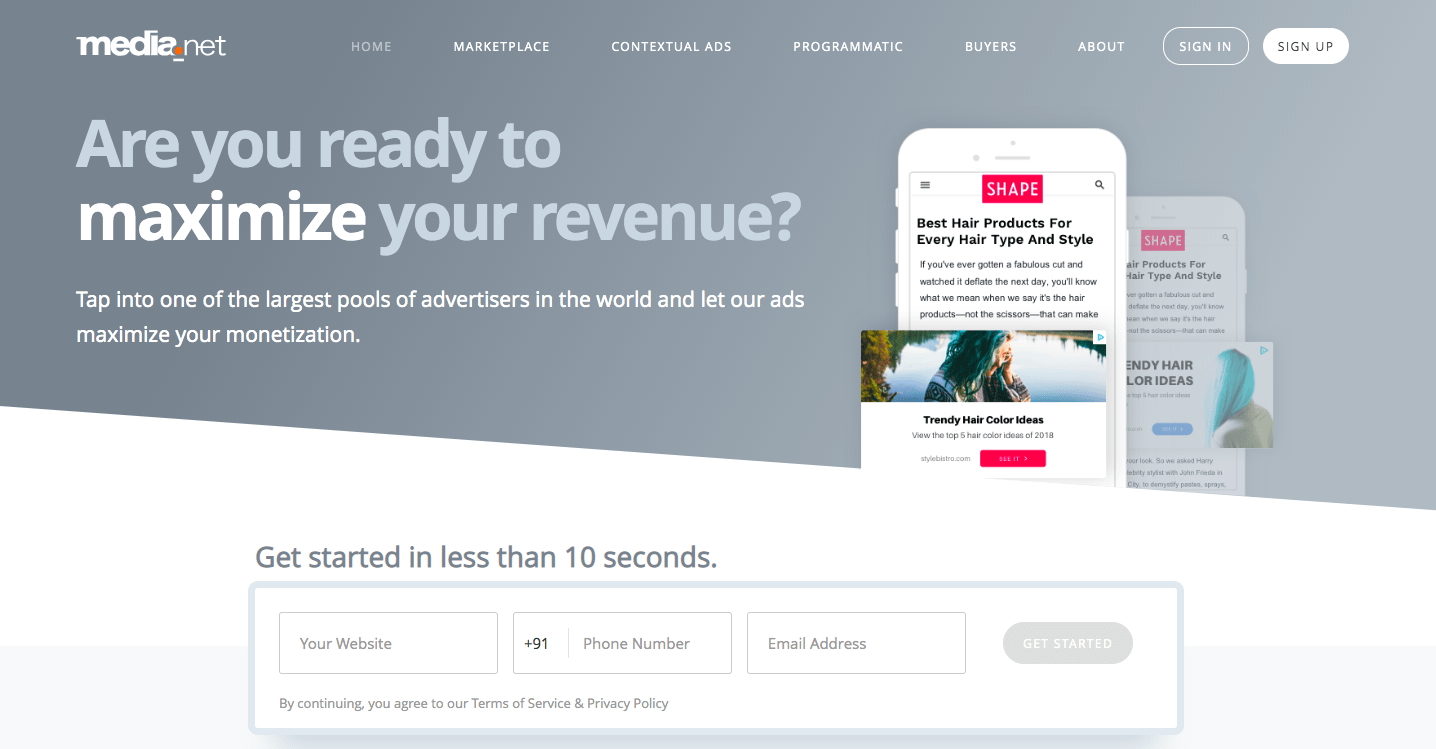
Media.net serves ads from the Yahoo! Bing contextual ad network, which comprises a large pool of national and local advertisers. This ensures a 100% fill rate across all verticals and ad formats. Some of Media.net’s publishers include Forbes, Elle, Reuters, Cosmopolitan, and CNN.
The ad network supports standard IAB ad sizes and has access to high-quality ads from all major DSPs. Moreover, Media.net supports display units desktop interstitial, in-content native, contextual ads, and mobile docked ads.
- Model: CPM, CPC, CPA
- Minimum traffic: None
Read more: Media.net Review
9. Infolinks
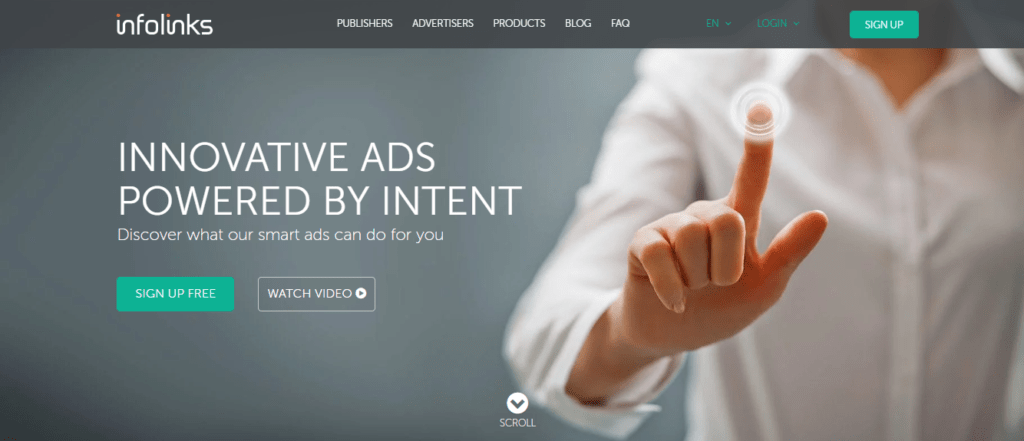
Banner ads, although popular, are associated with a major problem, i.e. banner blindness, where users (consciously or subconsciously) ignore the ads because they are viewed as an intrusion.
Infolinks gets around this problem by offering an innovative set of free-to-use and profitable ad units viz. InFold (overlay ads), InText (text links ads), InTag (tag cloud ads), InFrame (banner ads in margins and frames), and In-Screen (smart interstitial ads).
The availability of such solutions leads to better SEO, less intrusion for users, increased relevance, and better space utilization. Infolinks generates high monthly revenue for over 350,000 publishers. They are known to work with the biggest advertisers, namely Facebook, Microsoft, Amazon, and eBay.
The platform is simple enough to integrate with a website and is open to any publisher with no setup fees and no minimum page views or visitor requirements.
- Model: CPM, CPC, CPA, CPV, CPI, Auction
- Minimum traffic: None
Read more: Infolinks Review
10. RevenueHits
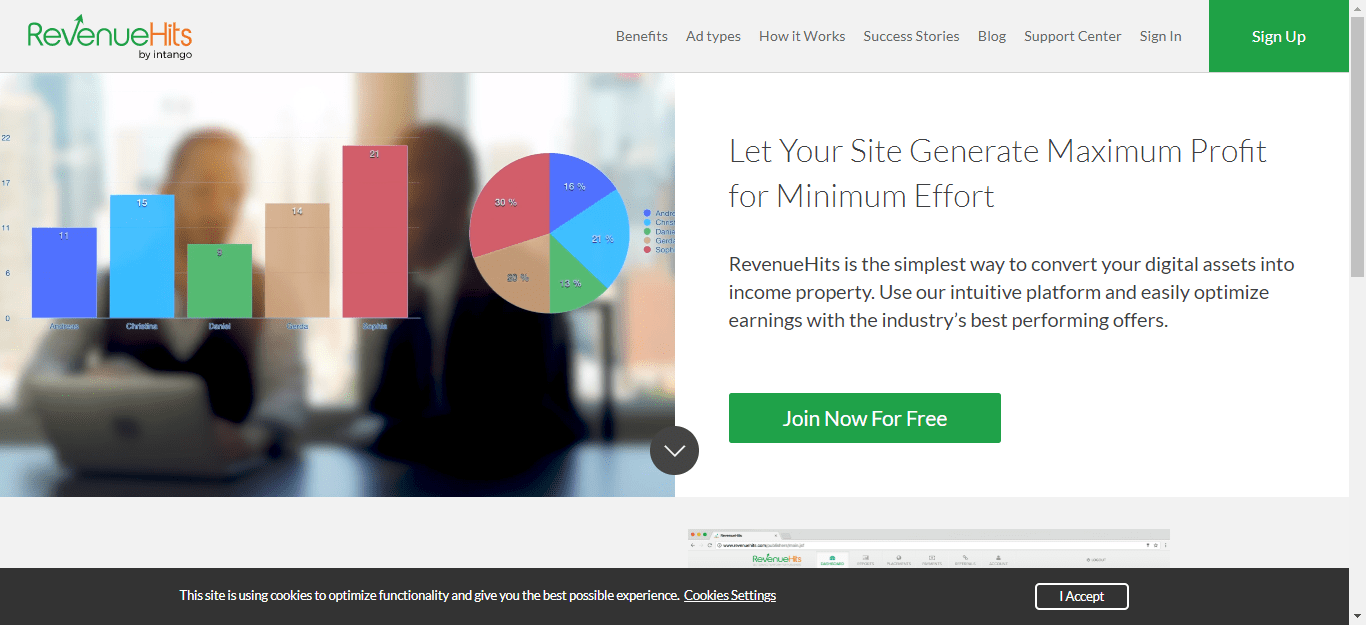
RevenueHits uses contextual and geo-targeted ad-serving technology, which makes it a favourable choice in times of GDPR. The ad network allows publishers to monetize websites, mobile sites, add-ons, widgets, toolbars, and more.
Known to be one of the best advertising platforms, RevenueHits promises a 100% fill rate across all geographic regions. Other than display ads, the ad network lets publishers monetize their websites using text ads, pop-ups, apps, widgets, XML feeds, and other custom formats.
- Model: CPM, CPC, CPA, CPV, Auction
- Minimum traffic: None
Read more: Infolinks Review
11. AdBlade
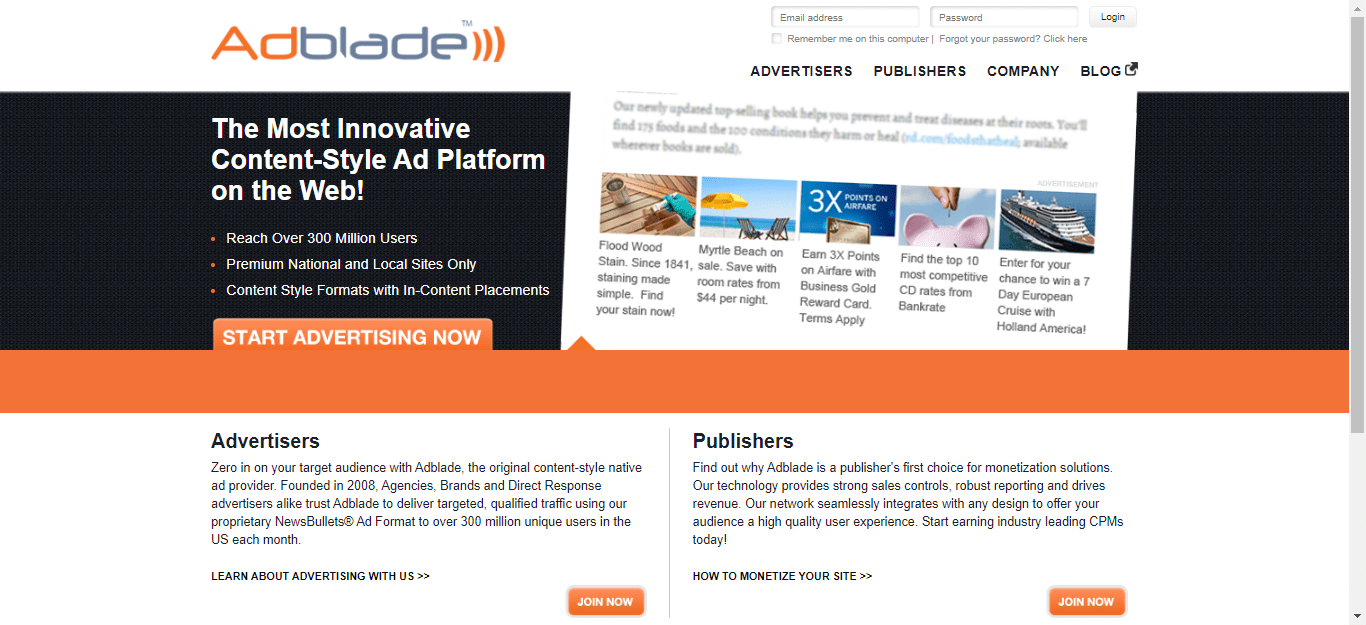
AdBlade is one of those ad networks that focus on quality over quantity. Further, FoxNews, Hearst Corporation, Yahoo!, and ABC are among the 1,000 that comprise this ad network.
AdBlade supports standard IAB units, as well as proprietary NewsBullets® units that claim to deliver up to 3X better performance.
- Model: CPM, CPC, Real-time bidding
- Minimum traffic: 500,000 monthly impressions
12. Undertone
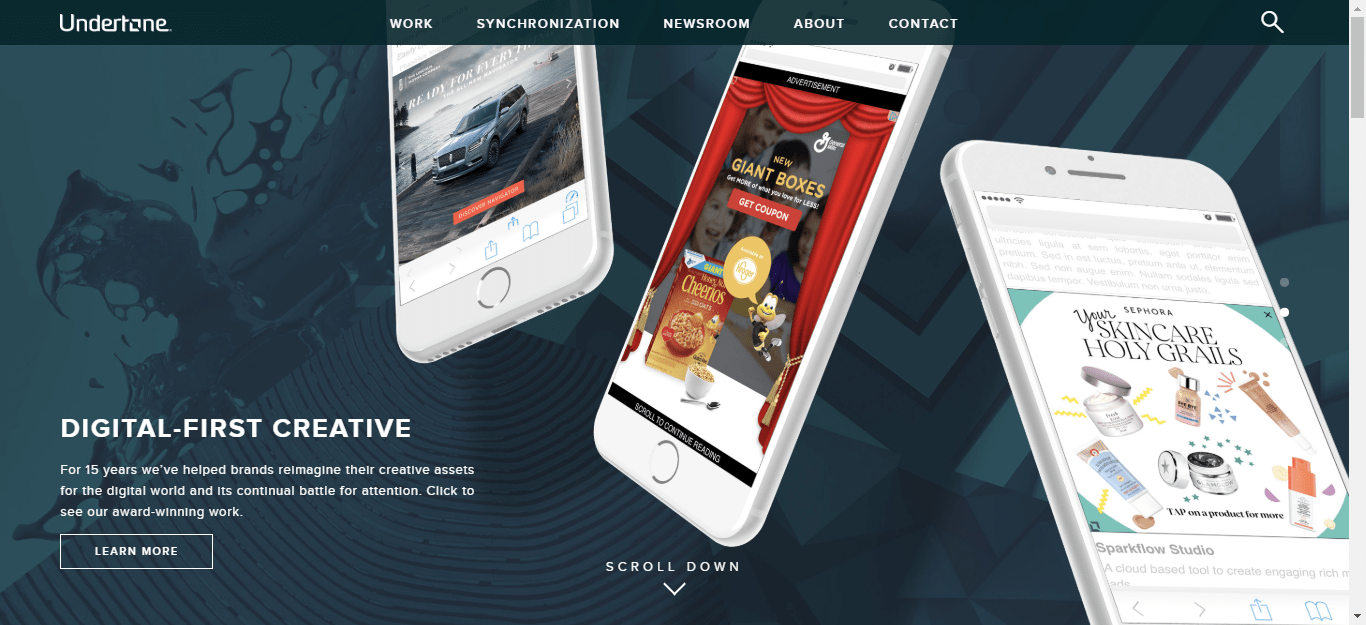
Undertone specializes in providing high-impact ad formats in addition to standard IAB formats. To clarify, formats like IAB rising stars, video formats, and its own range of flagship display formats are designed for higher user engagement.
This is coupled with the fact that many of Undertone’s proprietary ad units use the publisher’s ad inventory in non-traditional ways, thereby ensuring that there’s no cannibalization of existing ad products.
So this means that Undertone can offer CPMs that are 100%-1500% higher than traditional display ads.
- Model: CPM, CPC, CPA, CPV
- Minimum traffic: 500,000 monthly impressions
13. BidVertiser
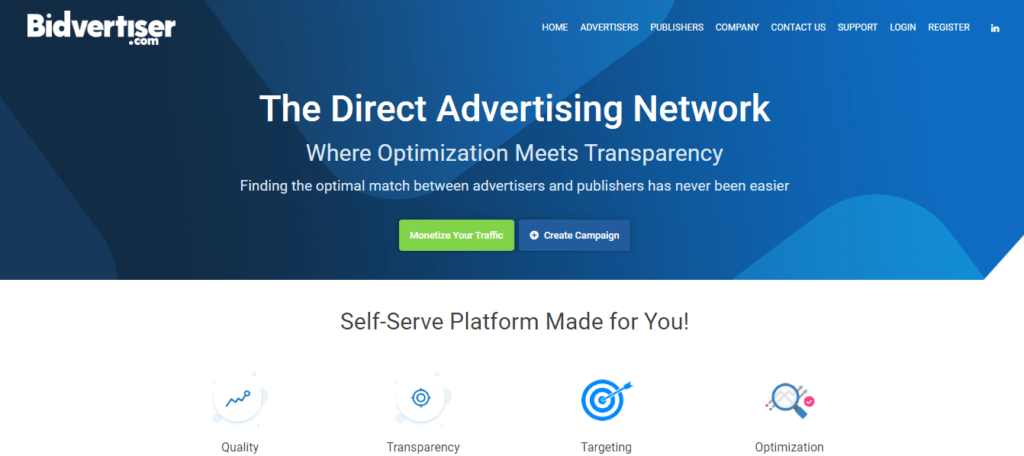
Though your mileage may vary, BidVertiser is an ad network with an interesting monetization model. In addition to earning money for each ad that is clicked, the publisher also earns additional revenue when the click leads to a conversion, i.e., sales for the advertiser.
BidVertiser supports multiple ad formats, including banners, skyscrapers, rectangles, and others. Also, publishers can use the provided point-and-click tool to customize the layout of these units to match their website’s look.
Their bidding system ensures that publishers always get the highest possible revenue from each ad unit. Using the reporting interface, publishers can easily monitor their ad performance, clicks, click-through rate, and the total amount they’ve earned.
- Model: CPM, CPC
- Minimum traffic: None
Read more: Bidvertiser Review
14. Vibrant Media
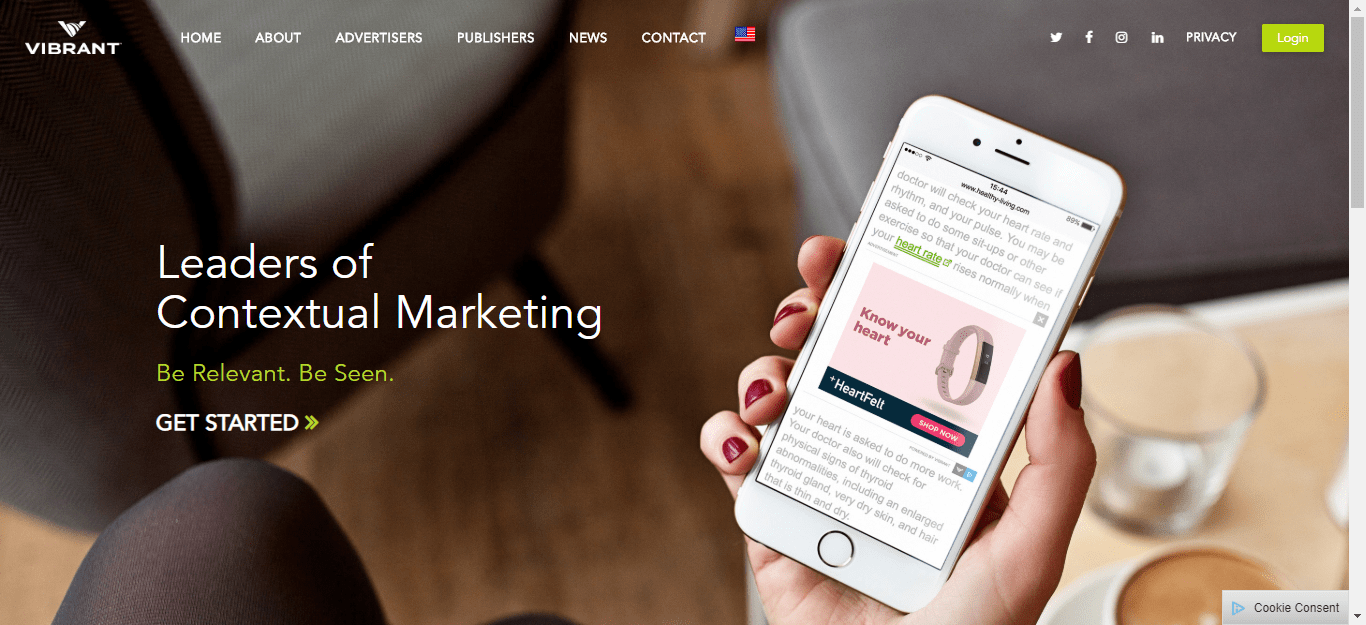
Vibrant Media offers Better-Ads and Chrome filter-friendly ad formats such as in-text, in-image, lightbox, storyboard, mosaic, and brand canvas in addition to the standard IAB display ad units.
Depending on the needs, publishers can choose to use Vibrant Media as their primary display ad network or can employ their native ad solutions to increase revenue without changing their existing ad configuration.
As a result, the ads are responsive and can be delivered across multiple platforms seamlessly.
- Model: CPM, CPC
- Minimum traffic: None
15. VerizonMedia
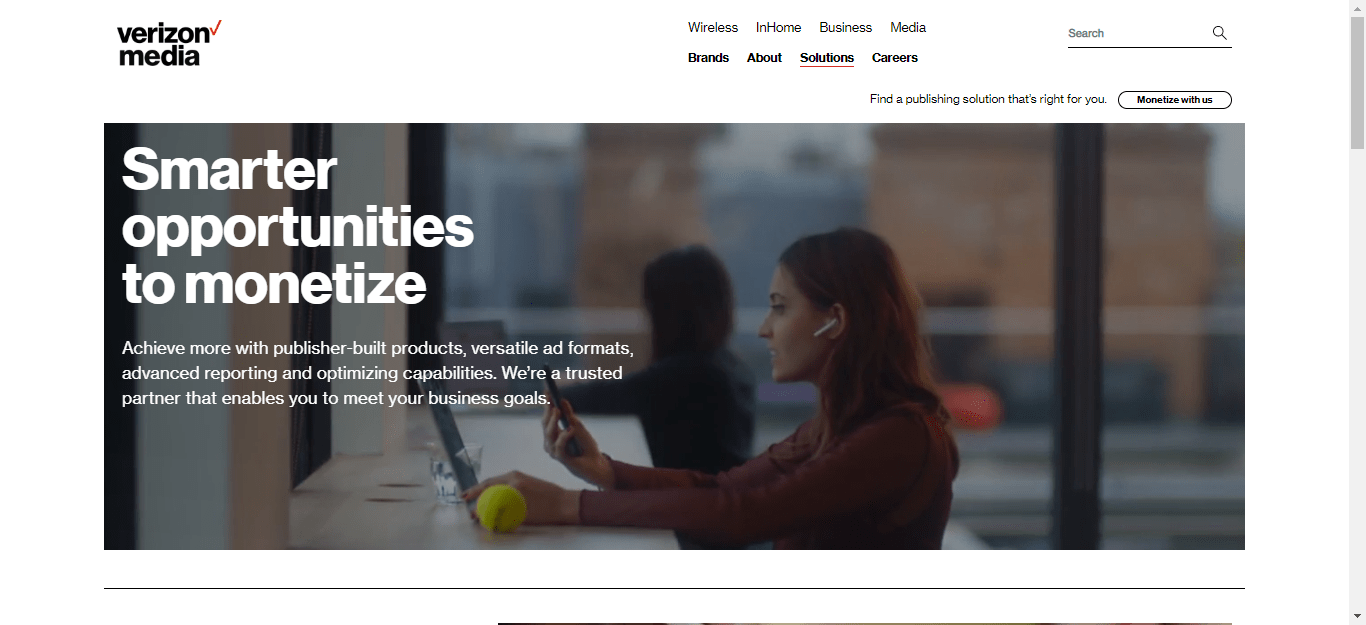
Known as Oath, the advertising company until January 2019, Verizon Media provides publishers with access to advertisers and ad server technology solutions, currently serving over 1000 direct publishers.
Their solutions allow publishers to choose from header bidding solutions to traditional publisher waterfall setups to attain premium demand for ad inventories. In addition, publishers are offered brand safety controls and seamlessly integrable tools to manage ad inventory.
The ad formats they support include display, mobile, native, and video ad inventories.
- Model: CPM, CPC, CPA
- Minimum traffic: 300,000 monthly impressions
16. Epom Market
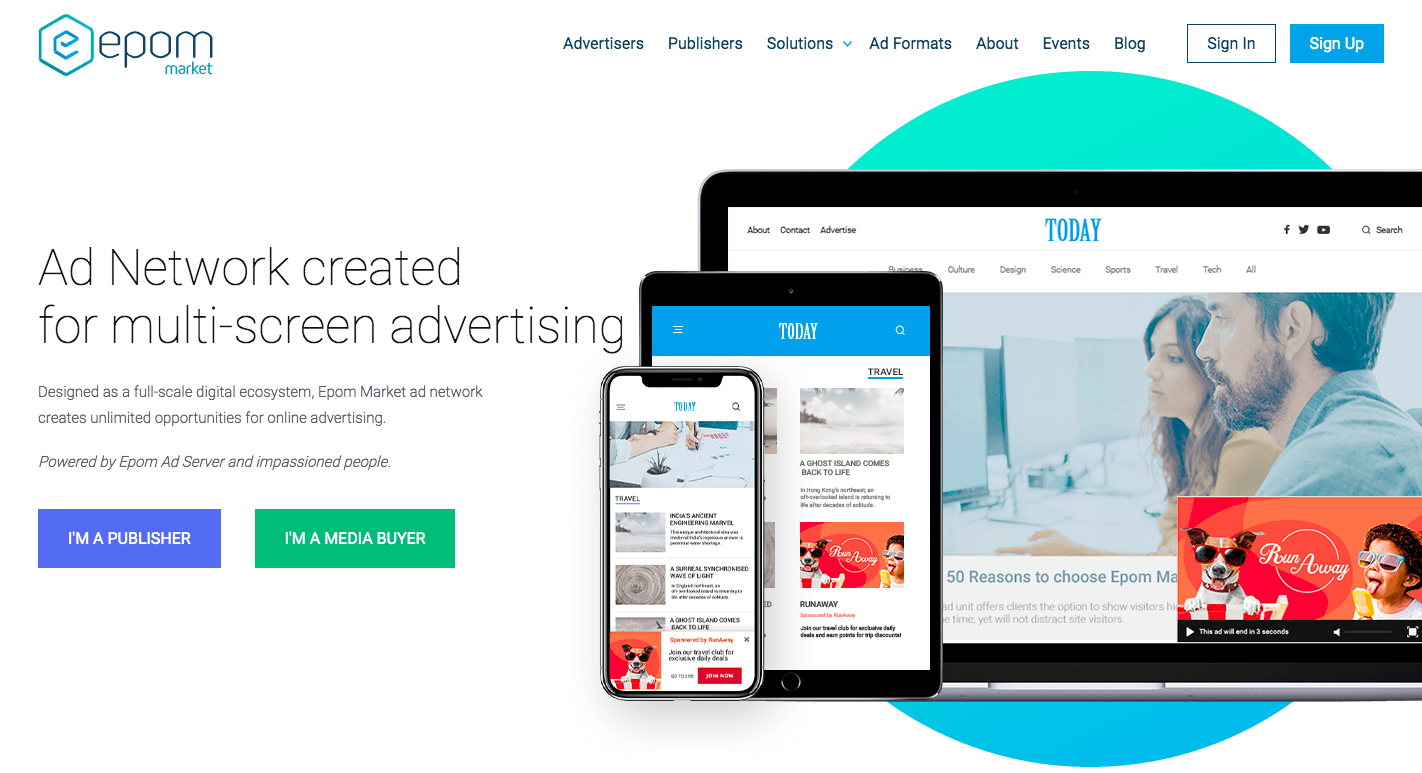
Epom Market is a cross-platform ad network associated with leading advertisers and publishers in over 40 countries across 15 verticals. Subsequently, the ad network serves 13 billion ad impressions and reaches an audience of 320 million unique monthly visitors per month.
It offers category-targeted, mobile, and local ads to ensure better user targeting, which leads to higher eCPM rates. Known to be among the best ad networks, Epom also supports footer, in-text, and mobile-specific ad units.
- Model: CPM, CPC, CPA, Auction
- Minimum traffic: 500,000 monthly impressions
17. Exponential
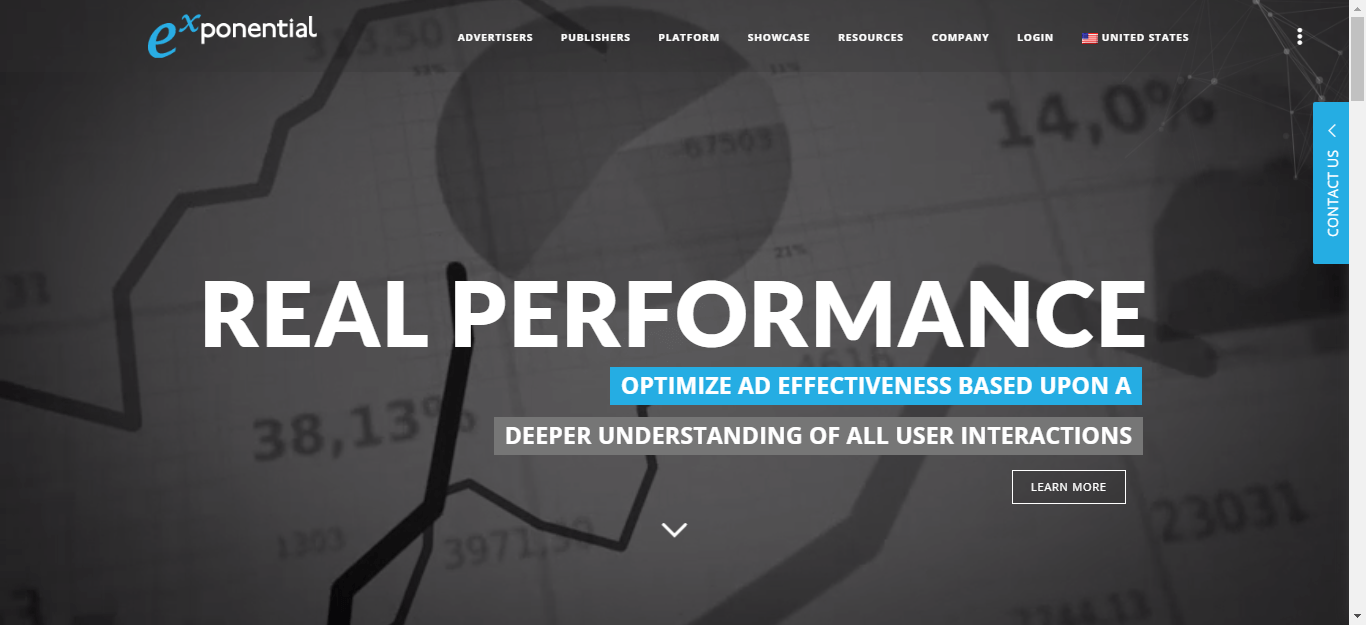
Exponential, formerly called Tribal Fusion, is an ad network known for its quality of CPMs ads. The ad network offers high-impact ads such as rising star and pre-roll ads. A 55% revenue share belongs to the publisher.
Exponential is very cautious about partnering with publisher websites and is on the lookout for publishers who maintain a professional and attractive website layout/design. Moreover, they recommend publishers keep relevant, highly-targeted, and updated content in order to partner with the Exponential ad network.
- Model: CPM, CPC, CPA
- Minimum traffic: 500,000 unique users per month
18. Propel Media
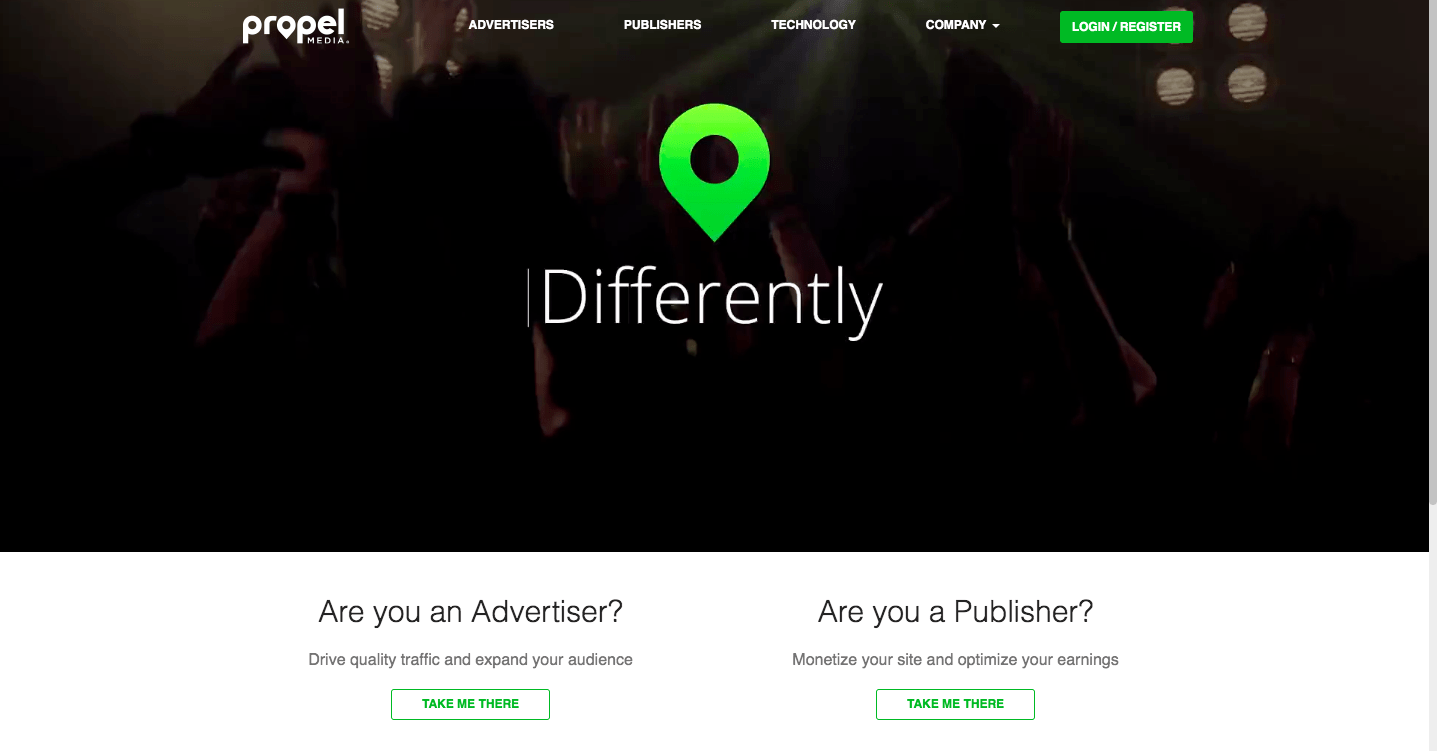
Propel Media, unarguably, is the best CPV/PPV (cost per view/pay per view) ad network known for reaching a high-intent audience. They specialize in reaching the audience through contextual text-links and display ads.
The ad network is known for its cooperative after-sales support and easy-to-use interface to optimize ads in a matter of seconds. The interface is supported by visual analytics to allow easy monitoring of trends and features to enable easy editing of the campaigns.
- Model: CPV/PPV
- Minimum traffic: None
19. AdMaven
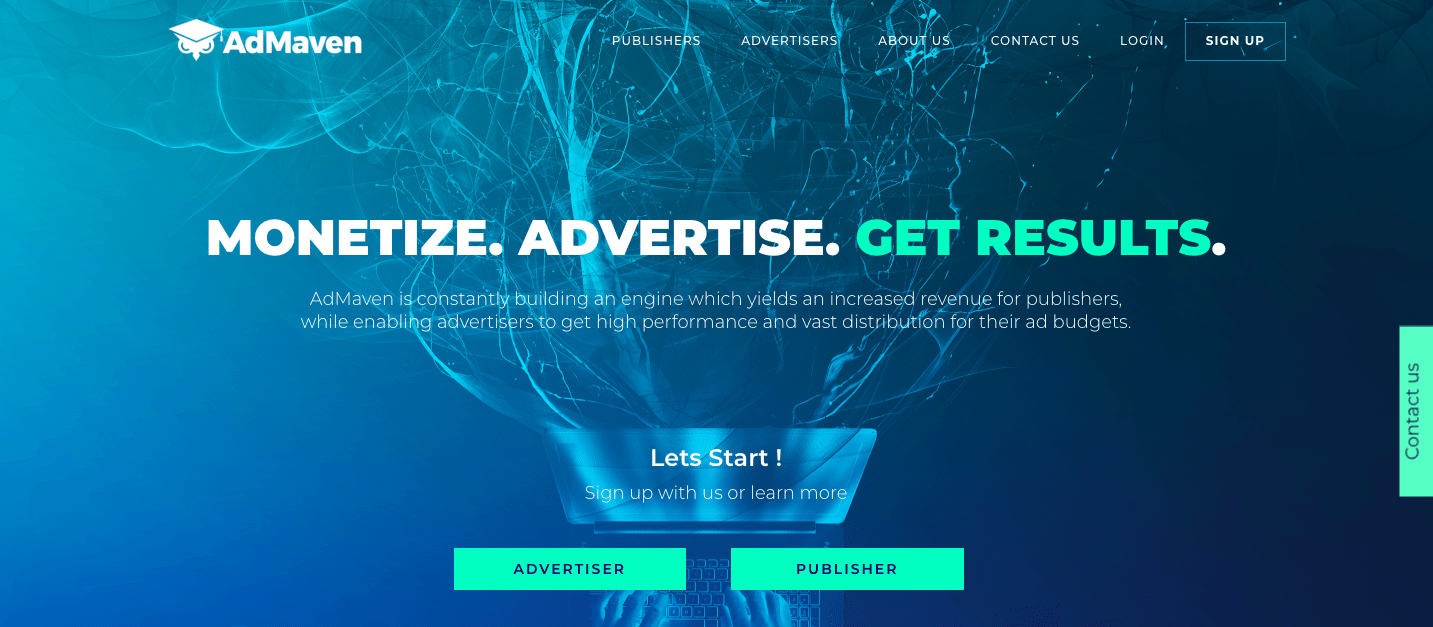
AdMaven is called the best pop-under ad network for publishers. However, the network also supports mainstream display ads including banner, lightbox, interstitial, and slider ads. They serve hundreds of millions of ad impressions in about 200 countries.
The bandwidth of their reach and impression gives advertisers a wide range of options to explore geotargeting. Their well-constructed and structured real-time bidding system also helps in precise targeting.
Currently, AdMaven has a publisher base of 25,000 who are monetizing their sites with them, which makes them one of the best ad networks.
- Model: CPA, CPI, CPL, CPC, CPM
- Minimum traffic: None
Read more: AdMaven Review
20. ClickAdu
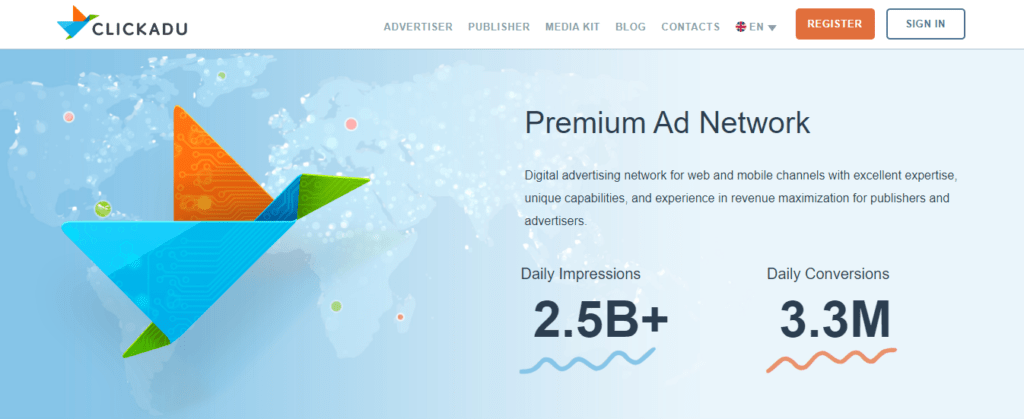
ClickAdu is one of the best digital advertising networks to maximize the revenue for publishers. They serve over 2.5 billion impressions daily with an active base of 2000 publishers and 15,000 campaigns.
In addition, the ad network offers high CPMs based in more than 240 countries with the assurance of a 100% ad fill rate. The most common ad formats they offer are pop-up ads, video, and pre-roll ads.
Above all, the ad network is soon going to serve display banner ads also, which could deliver a decent CPM-based model for publishers.
- Model: CPM
- Minimum traffic: None
Read more: Clickadu Review
21. HillTopAds
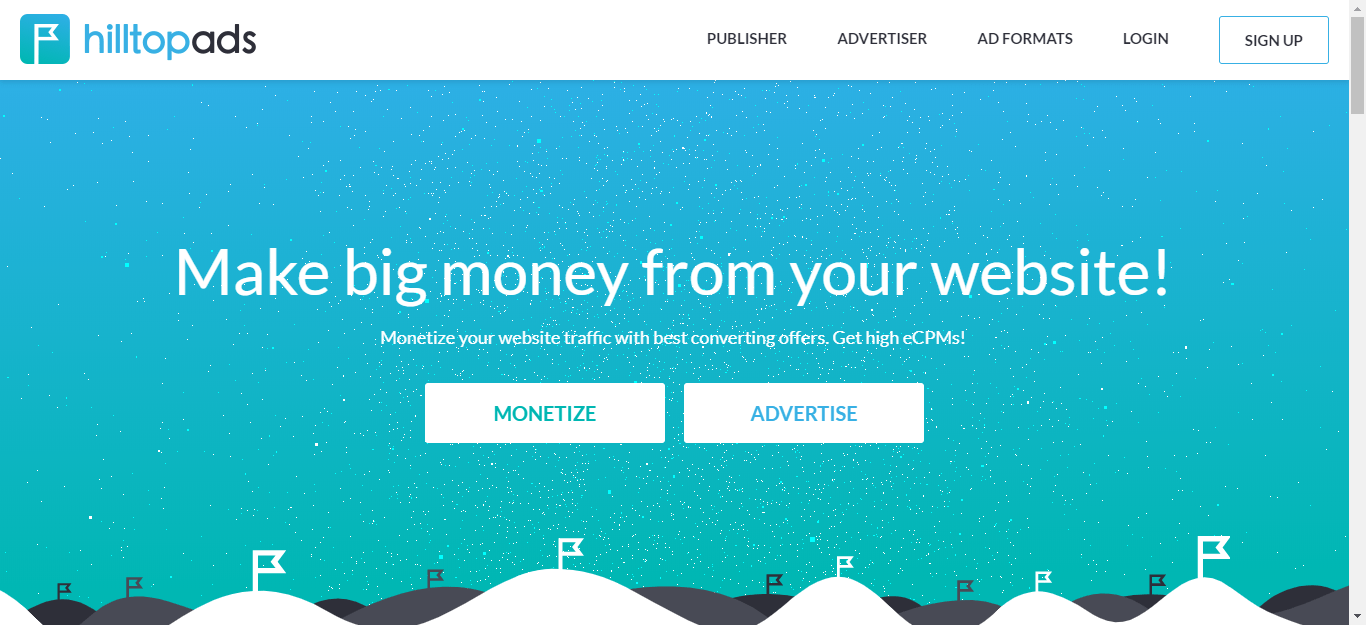
HillTopAds is a cheap ad network for publishers running medium- or high-traffic websites. They are popular for their anti-ad blocker technology to help publishers save the revenue often lost due to ad blockers deployed by users.
Their modern yet simple interface is easy for both intermediate and experienced publishers. And the ad network allows publishers to submit more than one website for monetization.
- Model: CPA, CPM, CPC
- Minimum traffic: None
22. EMX
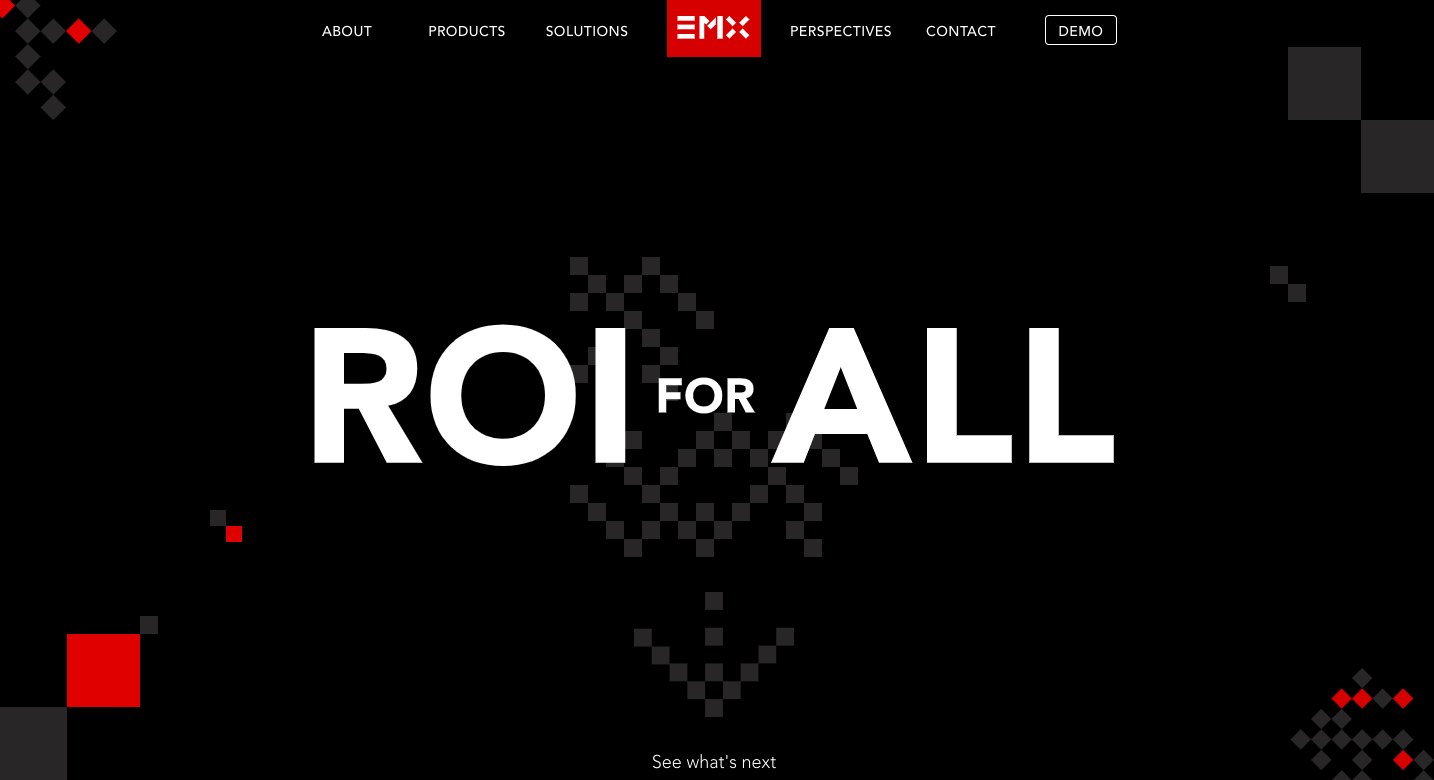
EMX, formerly called bRealTime, is an ad advertising network that caters to both publishers and advertisers. But, what separates EMX from other ad networks is that it offers fixed CPM pricing units.
The network is able to monetize publisher inventory across all geographies, especially helping the publishers who focus on traffic from multiple geographies apart from only tier-1 locations like US, UK, Canada, etc.
Their Biddr Connect feature helps publishers get advertisers’ demand from a global audience.
- Model: CPM
- Minimum traffic: 30,000 unique users per month
23. Google Ad Exchange
Google Ad Exchange (AdX), also referred to as simply AdX, is a programmatic advertising platform that connects publishers and advertisers to facilitate the buying and selling of ad space.
It operates as an open marketplace facilitating real-time bidding (RTB) between publishers selling ad inventory and advertisers vying for space. Recognized for its premium status, AdX provides access to a vast pool of high-quality advertisers and networks. Publishers integrate AdX code into their platforms, triggering auctions when users visit their sites. Advertisers bid based on user data and campaign objectives, with the highest bidder securing ad placement and publishers receiving payment accordingly.
How it works:
For publishers
- Publishers integrate the AdX code into their website or app, making their ad space available in the marketplace.
- When a user visits the publisher’s site, AdX triggers an auction, sending the user’s data and ad request to various advertisers.
- Advertisers bid on the ad space based on the user data and their campaign goals.
- The highest bidder wins the auction and their ad is displayed on the publisher’s website.
- Publishers receive payment based on the winning bid.
For advertisers:
- Advertisers access AdX through a demand-side platform (DSP), which allows them to manage their campaigns and bid on ad inventory across multiple exchanges, including AdX.
- They can set targeting criteria to reach specific audiences based on demographics, interests, and online behavior.
- When a user matches their targeting criteria, the DSP submits a bid on their behalf in the AdX auction.
24. Kadam
Kadam is an advertising network that aims to connect advertisers with publishers. They facilitate the buying and selling of ad space, enabling advertisers to reach their target audience and publishers to monetize their websites or apps.
Key Features:
- Wide reach: Covers all geographical regions (GEOs), reaching over 195 countries.
- Variety of ad formats: Provides access to popular ad formats like banners, native ads, push notifications (including in-app and on-site push), clickunder ads, and video ads.
- Targeting options: Offers detailed targeting options based on demographics, interests, device type, and more, allowing advertisers to reach specific audiences.
- Performance-based models: Supports various payment models like cost-per-impression (CPM), cost-per-click (CPC), cost-per-action (CPA), and CPA Target, allowing advertisers to pay based on their desired outcome.
- Fraud prevention: Claims to have built-in anti-fraud solutions to minimize the risk of fraudulent clicks and impressions.
- Analytics & reporting: Provides publishers with detailed insights into ad performance and user behavior.
Overall, Kadam is a multi-format ad network that caters to advertisers and publishers of all sizes. It offers a wide range of features and functionalities, making it a potential option for those seeking an alternative to larger ad networks.
25. TripleLift
TripleLift, founded in 2012, is a programmatic advertising technology company focusing on delivering premium ad experiences across online video, connected television (CTV), display, and native ads.
Their mission revolves around creating visually stunning ads, partnering with high-quality publishers, providing actionable data insights, and employing smart targeting techniques. For publishers, TripleLift facilitates monetization by granting access to premium advertisers, diverse ad formats, and analytical tools for optimization. Advertisers benefit from reaching targeted audiences through high-quality placements across screens, with campaign management and optimization tools provided by TripleLift.
TripleLift’s platform offers increased revenue potential and improved ad experiences for publishers, alongside actionable insights for optimizing placements.
For advertisers, it provides access to engaged audiences, advanced targeting capabilities, and high-quality placements that enhance brand image. Overall, TripleLift stands out as a prominent player in the programmatic advertising realm, offering a holistic solution catering to the needs of both publishers and advertisers seeking premium and effective advertising solutions.
26. Xandr (by Microsoft Ads)
Xandr, previously known as AppNexus, is a programmatic advertising platform owned by Microsoft Ads. It offers a comprehensive suite of tools and solutions for both advertisers and publishers, aiming to facilitate efficient and effective buying and selling of ad space across various digital channels.
Key Features of Xandr:
- Open & Flexible Platform: Supports various ad formats and integrates with various ad networks and exchanges, providing flexibility for both sides of the market.
- Data-Driven Approach: Utilizes data and analytics to help advertisers target specific audiences and measure campaign effectiveness.
- Focus on Innovation: Continuously develops new features and solutions to stay at the forefront of the programmatic advertising landscape.
Overall, it provides a comprehensive suite of tools and solutions for advertisers and publishers seeking a more efficient and effective approach to online advertising. Its focus on data, innovation, and access to premium inventory makes it a compelling option for those looking to navigate the ever-evolving programmatic advertising landscape.
27. PubMatic
PubMatic was established in 2006 and is a leading independent technology company focused on maximizing customer value by delivering the programmatic digital marketing supply chain of the future.
It holds a strong position in the programmatic advertising space with its commitment to transparency, data-driven solutions, and empowering both publishers and advertisers in the open internet ecosystem.
Here is what PubMatic offers:
- Omnichannel Sell-Side Platform (SSP): Helps publishers manage and sell ad inventory across various digital channels like display, video, mobile, and audio.
- Data & Insights: Provides publishers with real-time data and insights to understand audience behavior and optimize ad placements for better monetization.
- Focus on Transparency: PubMatic emphasizes transparency and building solutions that address industry challenges, fostering a healthy and open internet ecosystem.
28. OpenX
OpenX is a well-established independent Supply-Side Platform (SSP), meaning it helps publishers sell their ad inventory through programmatic auctions. They cater to various digital channels, including:
- Websites & Apps: Display, native, and video ads
- Connected TV (CTV): Video ads on streaming platforms
Key strengths of OpenX:
- Independence: Operating independently allows OpenX to prioritize innovation and fairness for both publishers and advertisers.
- Focus on Quality: They prioritize high-quality inventory, attracting trusted advertisers seeking engaged audiences.
- Technology & Innovation: OpenX invests heavily in technology, constantly developing new features and solutions to stay at the forefront of the programmatic landscape.
OpenX presents a compelling option for publishers seeking a reliable and innovative SSP that prioritizes high-quality inventory, data-driven solutions, and a commitment to sustainability.
29. Criteo
Criteo is a global technology company that operates a Commerce Media Platform (CMP). This means they offer technology and services for both advertisers and publishers related to online advertising and commerce.
For Advertisers:
- Reach relevant audiences: Criteo uses data-driven targeting based on browsing behavior and purchase history to help advertisers reach people who are likely to be interested in their products or services.
- Improve campaign performance: They offer various ad formats and campaign management tools to help advertisers optimize their campaigns for better results.
- Focus on measurement and attribution: Criteo provides tools to measure the effectiveness of campaigns and track how online advertising impacts sales.
For Publishers:
- Monetize their content: Criteo provides publishers with access to a large pool of advertisers, allowing them to monetize their online content through display advertising.
- Data & insights: They offer publishers data and insights about their audience to help them understand their users better and optimize their content strategy.
- Focus on user experience: Criteo aims to provide a good user experience for website visitors by delivering relevant and non-intrusive ads.
Criteo is a major player in the online advertising space, helping advertisers reach their target audience effectively and publishers monetize their content.
30. Sharethrough
Sharethrough is a global omnichannel ad exchange that focuses on providing a sustainable and user-friendly advertising experience for both publishers and advertisers. They aim to bridge the gap between these two parties by offering innovative solutions and prioritizing a healthy online advertising ecosystem.
Key strengths and differentiators of Sharethrough:
- Focus on sustainability: They prioritize building a sustainable advertising ecosystem through responsible ad practices and user-friendly experiences.
- Omnichannel approach: Sharethrough caters to both traditional and emerging digital advertising channels, offering flexibility for both publishers and advertisers.
- AI-powered technology: Their AI-based solutions help optimize ad performance and revenue for publishers.
- Commitment to quality: Sharethrough emphasizes high-quality, brand-safe inventory and engaging ad formats for both parties.
Overall, Sharethrough presents a unique option in the ad exchange landscape, focusing on user experience, sustainability, and innovative solutions for both publishers and advertisers.
30. 33across
33Across is a technology company operating in the field of programmatic advertising. This means they offer software solutions and services that help automate the buying and selling of ad space online.
Here are some key aspects of 33Across:
- Focus on privacy: They claim to prioritize data privacy and user security through various compliance measures.
- Independent provider: They operate as an independent company, not affiliated with any specific ad network or exchange.
- Global reach: Their solutions are available to publishers and advertisers worldwide.
They cater specifically to the following aspects:
- Identity Resolution: They help bridge the gap between different data sources to connect users across various devices and platforms, enabling better targeting and ad measurement.
- Programmatic Monetization: They provide publishers with tools and technology to sell their ad inventory efficiently through programmatic auctions.
- Audience Segmentation: They help advertisers segment their target audience based on various criteria, allowing for more precise and effective ad targeting.
In Closing
The choice is wide when it comes to ad networks, which means that every publisher can find their ideal solution. Publishers need to take into consideration their requirements and then make a decision regarding an ad network or an assortment of ad networks.
This list has solutions for all kinds of publishers, whether they are small-sized, large-sized, or in need of simple services. The right advertising network can help publishers monetize their websites efficiently. We advise them to go through trials for some options before choosing the best ad network.
Key Takeaways:
Short in Time? Here’s a quick summary of the article:
- Ad network definition: Ad networks work by collaborating with publishers (supply-side) and advertisers (demand-side) to help them reach their ad campaign goals.
- Types of ad networks: Premium Ads Network, Vertical Ad Networks, Inventory-Specific Ad Network, and Affiliate Advertising Network.
- Choose the best ad network: Publishers should keep these metrics in mind to choose the best ad network: Size of advertiser network, quality of ads. ad formats, and technology used.
- Top ad network: Some of the best ad networks include Pop Ads, Propeller Ads, Smarty Ads, Adsterra, Infolinks, and Bidvertiser.
Frequently Asked Questions:
Ad networks are known to efficiently work to sell remnant ad inventory. Basically, ad networks take remnant inventory from multiple publishers, segregate them on the basis of demographics, and sell the segmented impressions to advertisers specifically looking for similar impressions.
Some of the best paying ad networks include:
AdSense
Media.net.
Adcash
BuySellAds
Propeller Ads
Publishers work with Ad Networks to find opportunities to sell inventory that they are unable to sell through direct sales. Unsold inventory results in loss of revenue for the publisher.
Related Terms
- Ad Exchange: Ad exchange connects thousands of publishers and advertisers. It provides a platform to sell and buy ad inventories using its connections with various ad networks and SSPs.
- Ad Server: The ad server places targeted ads on your website(s) depending on the instruction received. It uses a server to store various types of ads and deliver them as per the user’s online behaviour.
- Ad Management: Advertising management is the process of overseeing and monitoring ad campaigns that seek to inform and attract consumers regarding a particular good or service.
- Ad Relevance: Ad relevance is defined as how closely an advertising campaign matches a user’s search determined by the correlation between keywords, ads, and post-click landing pages, as per Google.

Shubham is a digital marketer with rich experience working in the advertisement technology industry. He has vast experience in the programmatic industry, driving business strategy and scaling functions including but not limited to growth and marketing, Operations, process optimization, and Sales.
